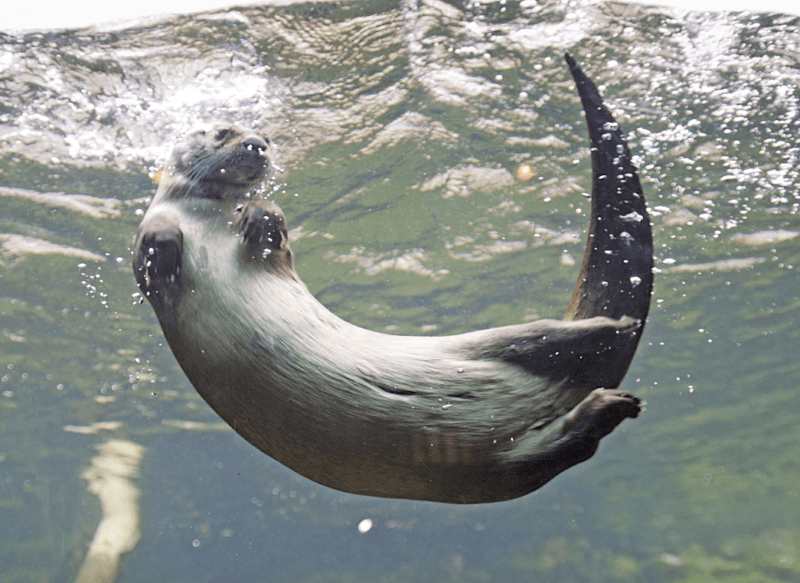
By Jim Knox
My colleague John and I watched intently as the sleek brown creature swam at an angle 30 yards beyond our canoe. We paddled vigorously then drifted, closing the distance in silence. What was a mystery at 30 yards, emerged into focus at 20 yards, and into wonder at 10. The swift enigmatic brown mass was not one creature but two; a mother safely transporting her small kit across the watery wilderness of Southern New York’s Great Swamp. With her kit secured by its scruff, “Mom’s Ferry Service” paddled just off our bow to a destination only she knew. We considered ourselves fortunate to witness this mammal in its element, going about its business, providing care for its family in its wild domain.
The American Mink (Neogale vison) is a creature familiar to many but well known by few. A member of the phenomenally successful weasel or Mustelidae Family, it is practically a member of mammal royalty. With 70 species in their ranks, the Mustelids form an incredibly diverse group of carnivores. Ranging in size from the world’s smallest carnivore—the 7-inch-long 5-ounce Least Weasel—to the 5-foot-long 119-pound Sea Otter, the mustelids span quite a variety of sizes. While they come in varying forms, the most familiar form is well, Mink-like.
Averaging two feet long and 2-3 pounds in weight, these semi-aquatic predators boast a bullet-like head and streamlined body adapted for pursuit of burrowing prey species and aiding speed in the water. Their famously dense yet sleek chocolate-brown water-repellent fur traps essential body heat. Most American Mink sport a small patch of white on the lower lip and chin and unlike their close weasel and otter cousins, they possess dark fur on their undersides.
With their exceptional swimming ability and acute vision, complemented by surprising climbing and burrowing ability, and refined hearing and sense of smell, mink are versatile, well-equipped hunters. Able to pinpoint and pursue elusive prey beneath the waves or among the leaves, these unrelenting carnivores are always in the hunt. Nocturnal by nature, they seek prey to fuel their turbo-charged metabolisms yet will adapt hunting routines to seize opportunities, targeting activity levels of their prey at all times of day.
One key to the mink’s success is its signature versatility. With a menu including insects, spiders, mussels, fingernail clams, freshwater shrimp, crayfish, frogs, turtles, snakes, fish (including lightning-fast Brook Trout), birds, mammals, and many others, the American Mink is able to find its next meal wherever its sharp senses guide it. While such versatility is no small feat, the mink’s ability to take down prey as large as, or larger than itself, is a key factor in its success. The mink’s aggressive unrelenting hunting strategy enables it to take down prey including Muskrats, Cottontail Rabbits, Great Black-backed Gulls, Canada Geese, and other species that would deter most like-sized predators.
Found throughout most of Canada and the United States with the exception of the scorching desert Southwest, the mink exploits habitat from coast to coast. With such aquatic and terrestrial capability, the mink is at home in most habitats, and can travel long distances overland to access promising rivers, streams, lakes, and marshes.
Inhabiting The Nutmeg State from the beaches to the Berkshires, the mink is at home statewide. From the Mianus River Gorge to the Noroton River and beyond, mink stalk the sandy banks and verdant forests of Fairfield County. A fleeting view of this mammal often leads to misidentification. Squirrels, weasels, juvenile River Otters, even wayward family ferrets are often incorrectly cited as these inconspicuous mammals, yet the telltale field mark of the uniform brown underside and white chin patch confirm the identity of this widespread yet poorly known carnivore.
So, what is it that makes the mink so successful? As with most species, it is a suite of traits that contributes to the mink’s vast range and healthy populations from coast to coast and north of the border.
In addition to its generalized design, keen senses, and disproportionate pound-for-pound strength, it is the behavioral mink within that confers success in the intensely competitive wild world. What sets the mink apart from the competition is its relentless tenacity. Mink are constantly on the go—tracking prey by sight, scent, and sound—uncovering opportunity around each stream bend and exploiting those opportunities with their speed, power, and agility.
While we may not consider it often, like the wild creatures around us, we each possess a unique portfolio of strengths and skills, some overt, some discrete. Incorporating the American Mink’s signature tenacity into our personal toolkit is nothing short of a blueprint for success. By reflecting upon the strategy of the mink, we identify an amazing model for emulation in our daily lives. After all, any creature that endeavors to outmaneuver a trout, earns a well-deserved fish dinner!
Jim Knox serves as the Curator of Education for Connecticut’s Beardsley Zoo and as a Science Advisor to The Bruce Museum. A proud Member of The Explorers Club, Jim enjoys sharing his passion for wildlife conservation with audiences in Connecticut and beyond.




